一、页面权限
封装指令权限,能简单快速实现按钮级别的权限判断
1.1 hasRole
角色权限处理
javascript
/**
* v-hasRole 角色权限处理
* Copyright (c) 2019 ruoyi
*/
import useUserStore from '@/store/modules/user'
export default {
mounted(el, binding, vnode) {
const { value } = binding
const super_admin = "admin"
// 从useUserStore中获取当前用户的角色列表
const roles = useUserStore().roles
// 如果传入的指令值存在,value为非空数组
if (value && value instanceof Array && value.length > 0) {
const roleFlag = value
// 验证用户是否具有指定角色之一,或者是否为超级管理员 admin
const hasRole = roles.some(role => {
return super_admin === role || roleFlag.includes(role)
})
// 如果不具有相应角色,则从DOM中移除该元素
if (!hasRole) {
el.parentNode && el.parentNode.removeChild(el)
}
} else {
throw new Error(`请设置角色权限标签值`)
}
}
}使用示例
javascript
<el-button v-hasRole="['admin', 'editor']">编辑</el-button>1.2 hasPermi
权限标识处理
javascript
import useUserStore from '@/store/modules/user'
export default {
mounted(el, binding, vnode) {
const { value } = binding
const all_permission = "*:*:*"
// 从useUserStore获取权限标识列表
const permissions = useUserStore().permissions
// 检查传入的指令值是否为非空数组
if (value && value instanceof Array && value.length > 0) {
const permissionFlag = value
// 判断用户权限是否有全部权限或具有指定权限
const hasPermissions = permissions.some(permission => {
return all_permission === permission || permissionFlag.includes(permission)
})
// 如果不具有指定权限,则移除DOM元素
if (!hasPermissions) {
el.parentNode && el.parentNode.removeChild(el)
}
} else {
throw new Error(`请设置操作权限标签值`)
}
}
}使用示例
javascript
<el-button v-hasPermi="['system:user:add', 'system:user:edit']">新增用户</el-button>1.3 使用示例
示例代码
javascript
<!-- 父组件 -->
<template>
<!-- hasRole 使用示例 -->
<div style="margin: 20px; padding: 20px; border: 1px solid #ccc;">
<h3>角色权限控制示例 (v-hasRole)</h3>
<el-button v-hasRole="['admin']" type="primary">仅管理员可见</el-button>
// hasRole.js中设置了admin所有可见,所以这里v-hasRole="['common']" 管理员也是有权限的
<el-button v-hasRole="['common']" type="success">编辑者和管理员可见</el-button>
</div>
<!-- hasPermi 使用示例 -->
<div style="margin: 20px; padding: 20px; border: 1px solid #ccc;">
<h3>操作权限控制示例 (v-hasPermi)</h3>
<el-button v-hasPermi="['system:user:add']" type="primary">新增用户</el-button>
<el-button v-hasPermi="['system:user:edit']" type="success">编辑用户</el-button>
<el-button v-hasPermi="['system:user:remove']" type="danger">删除用户</el-button>
<el-button v-hasPermi="['system:user:add', 'system:user:edit']" type="warning">新增或编辑用户</el-button>
</div>
<!-- 函数式权限检查示例 -->
<div style="margin: 20px; padding: 20px; border: 1px solid #ccc;">
<h3>函数式权限检查</h3>
<div v-if="checkRole(['admin'])">
<p>这是通过函数检查显示的内容 - 仅管理员可见</p>
</div>
<div v-if="checkPermi(['system:config:edit'])">
<p>这是通过函数检查显示的内容 - 编辑者和管理员可见</p>
</div>
</div>
</template>
<script setup>
import { checkPermi, checkRole } from '@/utils/permission'
</script>admin账号查看
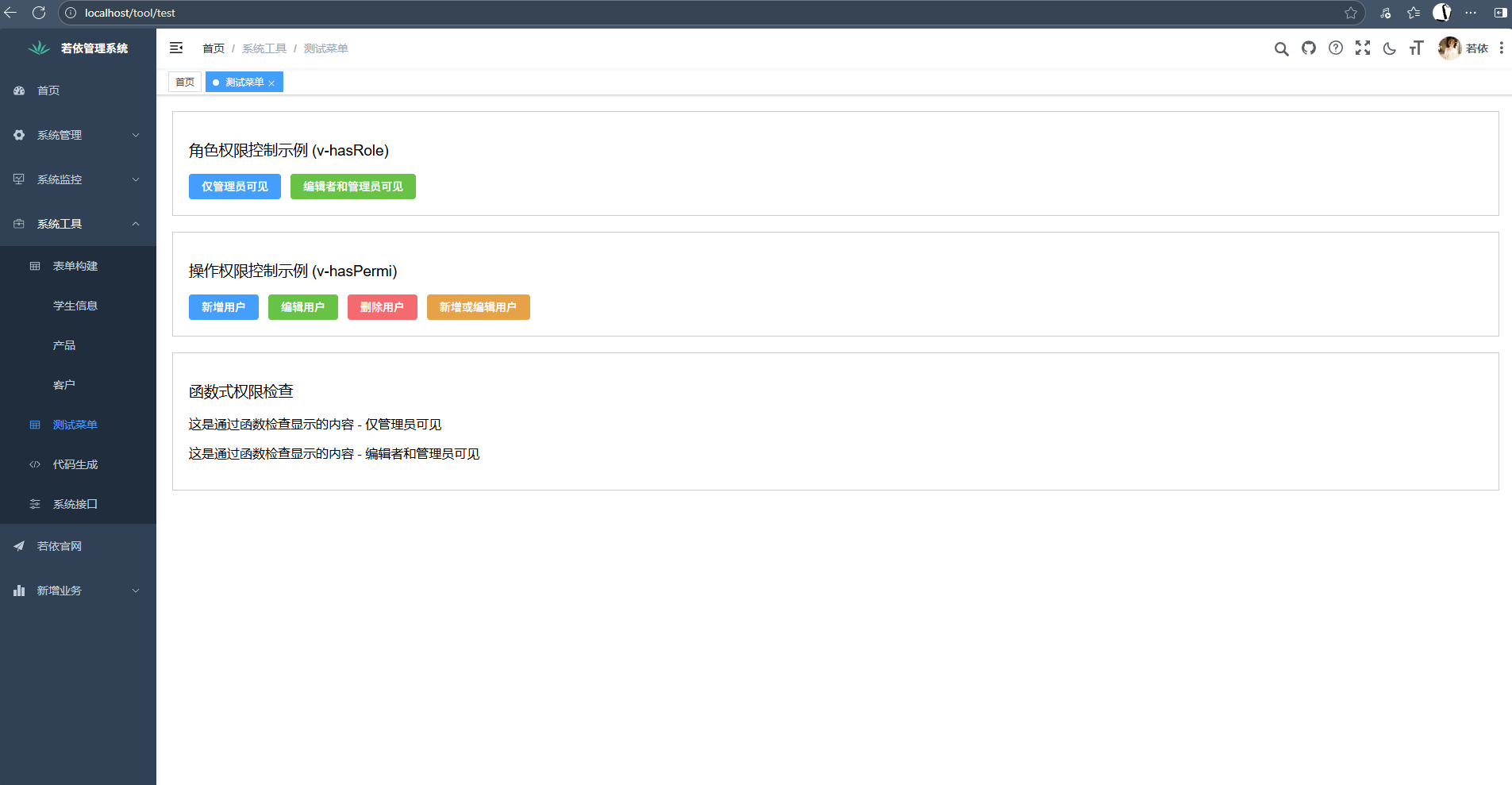
ry(普通角色)账号查看
这里注意要给普通角色添加新增的目录权限
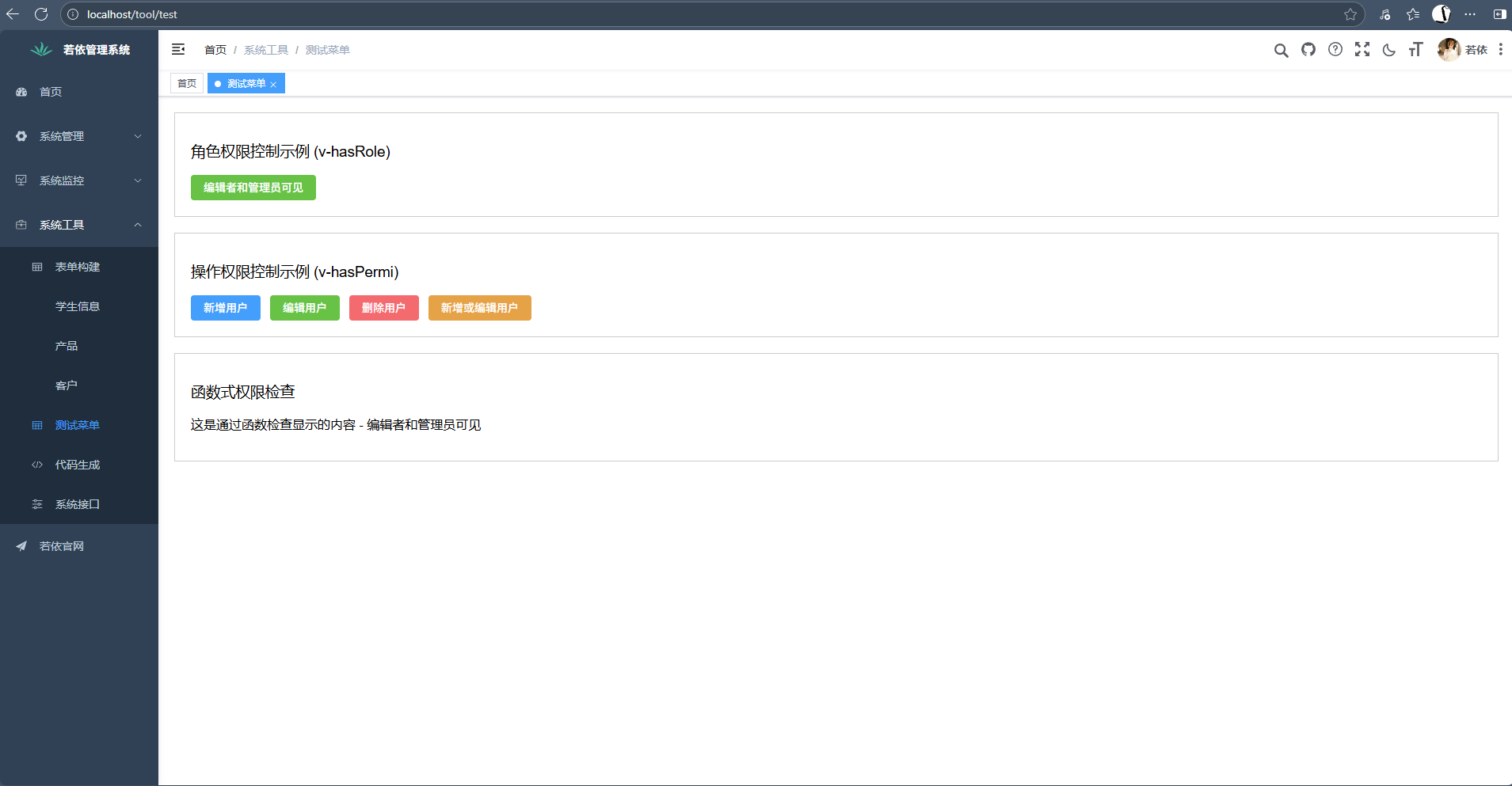
v-if 是 Vue 的条件渲染指令,它根据表达式的真假值来决定是否渲染某个元素或组件;当 v-if 的值为 true 时,元素会被渲染到 DOM 中;
当 v-if 的值为 false 时,元素不会被渲染到 DOM 中(完全不存在于 DOM 树中)
二、页签缓存
页签缓存是一个重要的用户体验优化功能。在ruoyi中,它允许用户在切换不同页面时保持页面状态,避免重复加载和数据丢失。在ruoyi中,页签缓存主要通过Vue的组件实现
javascript
<template>
<section class="app-main">
<router-view v-slot="{ Component, route }">
<transition name="fade-transform" mode="out-in">
<keep-alive :include="tagsViewStore.cachedViews">
<component v-if="!route.meta.link" :is="Component" :key="route.path"/>
</keep-alive>
</transition>
</router-view>
</section>
</template>- keep-alive是Vue内置组件,用于缓存动态组件
- :include="tagsViewStore.cachedViews"指定了需要缓存的组件列表
- 只有在cachedViews数组中的组件才会被缓存
使用keep-alive进行组件缓存时,必须确保路由配置和组件的name属性保持一致,否则会导致缓存失效或者出现其他问题。在Vue中,keep-alive组件通过include属性来决定哪些组件需要被缓存。默认情况下,keep-alive会优先匹配组件的name属性。如果路由配置中的name与组件定义的name不一致,就会导致缓存机制失效。
在系统管理-菜单管理中可以配置菜单页签是否缓存,默认为缓存。
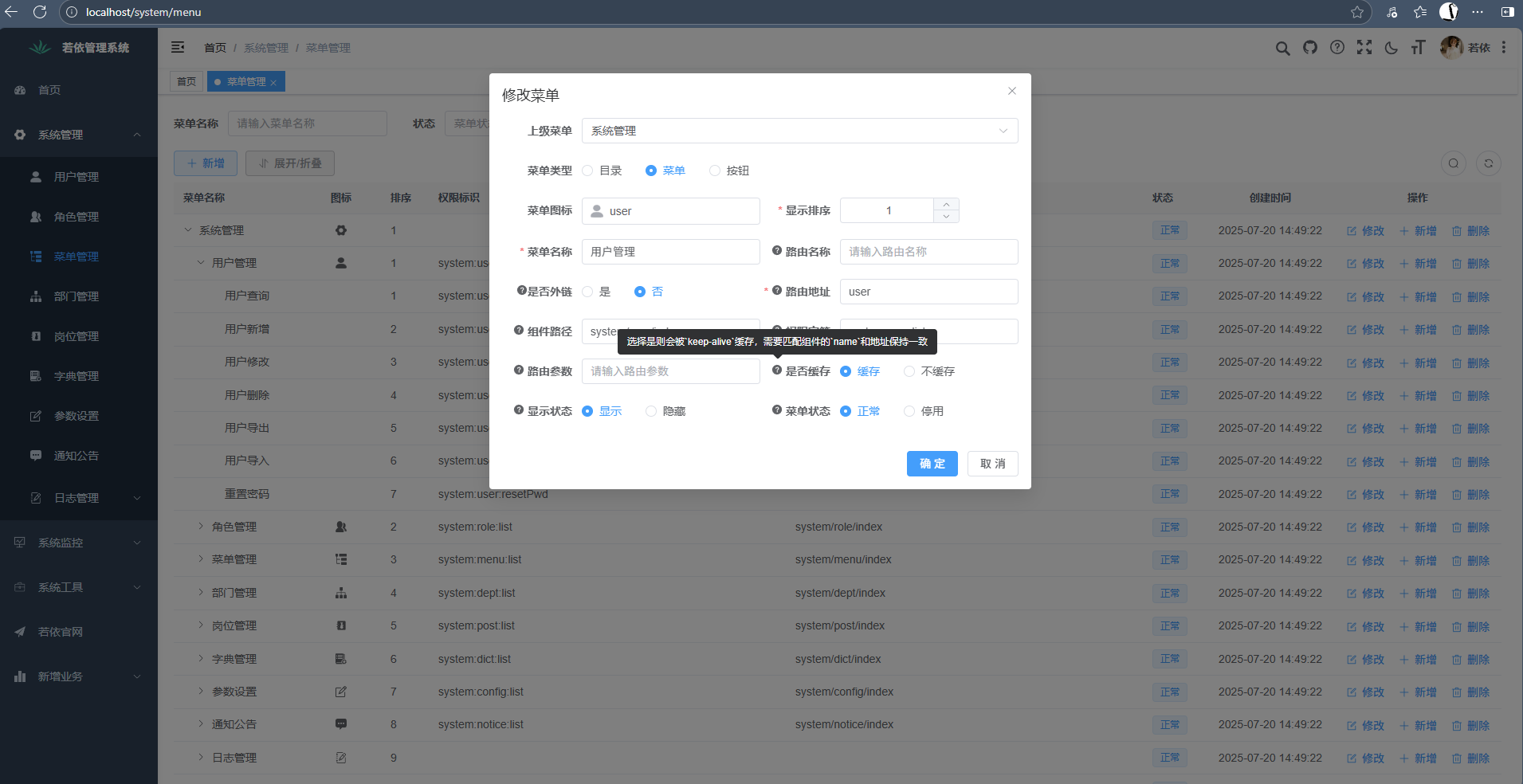
缓存的具体管理在src→store→modules→tagsViews.js中具体实现
javascript
addCachedView(view) {
// 如果该页面已在缓存列表中,则不再重复添加
if (this.cachedViews.includes(views.name)) return
// 如果该页面的路由配置中meta.noCache不为true,则将路由的name添加到缓存列表
if (!view.meta.noCache) {
this.cachedViews.push(view.name)
}
}实际使用场景
1.用户首次访问/system/user页面,系统会加载用户管理组件
2.由于该路由未设置meta.noCache=true,所以该页面组件会被添加到cachedViews列表中
3.当用户切换到其他页面(如角色管理)再切换回来时,由于组件已在cachedViews列表中,keep-alive会直接从缓存中恢复组件状态,而不会重新创建组件
4.这样用户在用户管理页面中的操作状态(如表格的分页、筛选条件等)会被保留
三、使用图标
3.1 图标
icon图标放在src→assets→icons下
3.2 全局SvgIcon组件
src→components→SvgIcon→index.vue
javascript
<template>
<svg :class="svgClass" aria-hidden="true">
<use :xlink:href="iconName" :fill="color" />
</svg>
</template>
<script>
export default defineComponent({
// 定义从父组件接收的值
props: {
iconClass: {
type: String,
required: true
},
className: {
type: String,
default: ''
},
color: {
type: String,
default: ''
},
},
setup(props) {
// 要在模板中使用的响应式数据和方法
return {
iconName: computed(() => `#icon-${props.iconClass}`),
svgClass: computed(() => {
if (props.className) {
return `svg-icon ${props.className}`
}
return 'svg-icon'
})
}
}
})
</script>
// 定义组件样式
<style scope lang="scss">
.sub-el-icon,
.nav-icon {
display: inline-block;
font-size: 15px;
margin-right: 12px;
position: relative;
}
.svg-icon {
width: 1em;
height: 1em;
position: relative;
fill: currentColor;
vertical-align: -2px;
}
</style>使用方式
javascript
<!-- icon-class 为 icon 的名字; class-name 为 icon 自定义 class-->
javascript
<!-- 基本用法 -->
<svg-icon icon-class="user" />
<!-- 带颜色 -->
<svg-icon icon-class="edit" color="#409EFF" />
<!-- 带额外CSS类 -->
<svg-icon icon-class="dashboard" class-name="custom-class" />实际示例
javascript
<script setup>
</script>
<template>
<div class="app-container">
msg
</div>
<svg-icon icon-class="user" color = "#409EFF" class-name="user-class"/>
<svg-icon icon-class="password" class-name="password-class"/>
</template>
<style scoped lang="scss">
.password-class{
font-size: 200px;
fill: red;
}
</style>显示效果
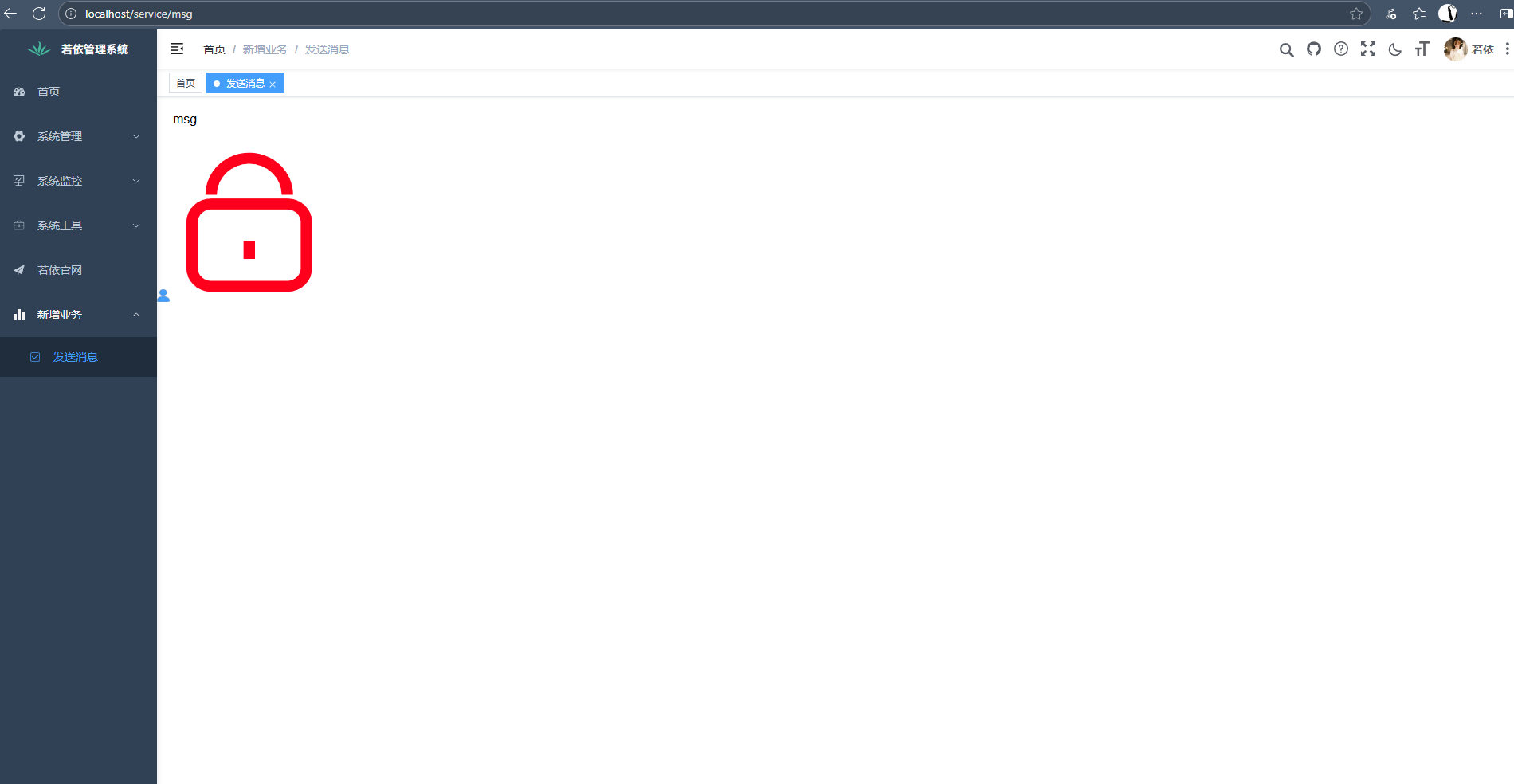
3.3 新增图标
提示
如果是从iconfont下载的图标,记得使用如 Sketch 等工具规范一下图标的大小问题,不然可能会造成项目中的图标大小尺寸不统一的问题。 项目中使用的图标都是 128*128 大小规格的。
将新图标放到src→assets→icons下,并使用即可,如:
javscript
<svg-icon icon-class="newIcon" class-name="newIcon-class"/>四、使用字典
数据字典系统是一个重要的功能模块,用于管理系统中的各种枚举数据,如状态、性别、类型等。它通过前后端配合,实现了数据字典的统一管理和使用。
流程:
1.初始化:通过 useDict 函数加载所需字典数据
2.缓存:将获取的字典数据存储在 dict.js 存储模块中,避免重复请求
3.显示:通过 DictTag 组件根据字典值显示对应标签
4.更新:当字典数据发生变化时,可以刷新缓存
4.1 核心组件和实现
4.1.1 DictTag组件
src→components→DictTag→index.vue是项目中用于显示字典标签的核心组件,它可以根据字典值显示对应的标签文本,并支持不同的显示样式。
javascript
<template>
<div>
// 遍历所有字典选项
<template v-for="(item, index) in options">
// 通过 values.includes(item.value) 判断当前值是否匹配字典项
<template v-if="values.includes(item.value)">
<span
// 根据是否有自定义样式类和类型,决定使用普通 span 标签还是 el-tag 组件显示
v-if="(item.elTagType == 'default' || item.elTagType == '') && (item.elTagClass == '' || item.elTagClass == null)"
:key="item.value"
:index="index"
:class="item.elTagClass"
>{{ item.label + " " }}</span>
<el-tag
v-else
:disable-transitions="true"
:key="item.value + ''"
:index="index"
:type="item.elTagType"
:class="item.elTagClass"
>{{ item.label + " " }}</el-tag>
</template>
</template>
</div>
</template>
<script setup>
// 记录未匹配的项
const unmatchArray = ref([])
// 接收属性
const props = defineProps({
// 数据
options: {
type: Array,
default: null,
},
// 当前的值
value: [Number, String, Array],
// 当未找到匹配的数据时,显示value
showValue: {
type: Boolean,
default: true,
},
// 分隔符,默认为逗号
separator: {
type: String,
default: ",",
}
})
// 计算属性 values 用于处理传入的值,将其统一转换为字符串数组
const values = computed(() => {
if (props.value === null || typeof props.value === 'undefined' || props.value === '') return []
return Array.isArray(props.value) ? props.value.map(item => '' + item) : String(props.value).split(props.separator)
})
const unmatch = computed(() => {
unmatchArray.value = []
// 没有value不显示
if (props.value === null || typeof props.value === 'undefined' || props.value === '' || !Array.isArray(props.options) || props.options.length === 0) return false
// 传入值为数组
let unmatch = false // 添加一个标志来判断是否有未匹配项
values.value.forEach(item => {
if (!props.options.some(v => v.value === item)) {
unmatchArray.value.push(item)
unmatch = true // 如果有未匹配项,将标志设置为true
}
})
return unmatch // 返回标志的值
})
function handleArray(array) {
if (array.length === 0) return ""
return array.reduce((pre, cur) => {
return pre + " " + cur
})
}
</script>
<style scoped>
.el-tag + .el-tag {
margin-left: 10px;
}
</style>4.1.2 字典获取工具
src→utils→dict.js 用于获取字段数据的工具函数
javascript
import useDictStore from '@/store/modules/dict'
import { getDicts } from '@/api/system/dict/data'
/**
* 获取字典数据
*/
// 接收多个字典类型参数
export function useDict(...args) {
const res = ref({})
return (() => {
// 循环处理每个参数
args.forEach((dictType, index) => {
res.value[dictType] = []
// 先尝试从本地获取
const dicts = useDictStore().getDict(dictType)
if (dicts) {
res.value[dictType] = dicts
} else {
// 本地没有则调用api获取
getDicts(dictType).then(resp => {
// 将获取到的数据转换为统一格式(包含 label、value、elTagType、elTagClass)
res.value[dictType] = resp.data.map(p => ({ label: p.dictLabel, value: p.dictValue, elTagType: p.listClass, elTagClass: p.cssClass }))
useDictStore().setDict(dictType, res.value[dictType])
})
}
})
return toRefs(res.value)
})()
}字典api接口
src→api→system→dict→data.js
javascript
// 根据字典类型查询字典数据信息
export function getDicts(dictType) {
return request({
url: '/system/dict/data/type/' + dictType,
method: 'get'
})
}4.1.3 字典存储
src→store→modules→dict.js 存储模块管理字典数据,避免重复请求
javascript
const useDictStore = defineStore(
'dict',
{
state: () => ({
dict: new Array()
}),
actions: {
// 获取字典
getDict(_key) {
if (_key == null && _key == "") {
return null
}
try {
for (let i = 0; i < this.dict.length; i++) {
if (this.dict[i].key == _key) {
return this.dict[i].value
}
}
} catch (e) {
return null
}
},
// 设置字典
setDict(_key, value) {
if (_key !== null && _key !== "") {
this.dict.push({
key: _key,
value: value
})
}
},
// 删除字典
removeDict(_key) {
var bln = false
try {
for (let i = 0; i < this.dict.length; i++) {
if (this.dict[i].key == _key) {
this.dict.splice(i, 1)
return true
}
}
} catch (e) {
bln = false
}
return bln
},
// 清空字典
cleanDict() {
this.dict = new Array()
},
// 初始字典
initDict() {
}
}
})
export default useDictStore4.2 实际使用示例
在用户管理模块中的使用
在src/views/system/user/index.vue中
javascript
// 获取两个字典 sys_normal_disable: 通用状态字典(正常/停用),sys_user_sex: 用户性别字典
const { sys_normal_disable, sys_user_sex } = proxy.useDict("sys_normal_disable", "sys_user_sex")模板中使用
javascript
<!-- 状态选择 -->
<el-select v-model="queryParams.status" placeholder="用户状态" clearable style="width: 240px">
<el-option v-for="dict in sys_normal_disable" :key="dict.value" :label="dict.label" :value="dict.value" />
</el-select>
<!-- 性别选择 -->
<el-select v-model="form.sex" placeholder="请选择">
<el-option v-for="dict in sys_user_sex" :key="dict.value" :label="dict.label" :value="dict.value"></el-option>
</el-select>
<!-- 状态显示 -->
<el-table-column label="状态" align="center" key="status" v-if="columns[5].visible">
<template #default="scope">
<el-switch
v-model="scope.row.status"
active-value="0"
inactive-value="1"
@change="handleStatusChange(scope.row)"
></el-switch>
</template>
</el-table-column>在字典数据管理中的使用
在 src/views/system/dict/data.vue 中:
javascript
<el-table-column label="状态" align="center" prop="status">
<template #default="scope">
// 这里使用了DicTag组件显示状态,通过:options传入字典选项,通过:value传入当前值
<dict-tag :options="sys_normal_disable" :value="scope.row.status" />
</template>
</el-table-column>字典更新机制
在 src/views/system/dict/data.vue中
javascript
/** 提交按钮 */
function submitForm() {
proxy.$refs["dataRef"].validate(valid => {
if (valid) {
if (form.value.dictCode != undefined) {
updateData(form.value).then(response => {
// 更新字典后清除缓存
useDictStore().removeDict(queryParams.value.dictType)
proxy.$modal.msgSuccess("修改成功")
open.value = false
getList()
})
} else {
addData(form.value).then(response => {
// 新增字典后清除缓存
useDictStore().removeDict(queryParams.value.dictType)
proxy.$modal.msgSuccess("新增成功")
open.value = false
getList()
})
}
}
})
}点击刷新缓存按钮,调用api /system/dict/data 刷新缓存
五、使用参数
参数设置是提供开发人员、实施人员的动态系统配置参数,不需要去频繁修改后台配置文件,也无需重启服务器即可生效。
5.1 参数修改流程
1.查看参数列表
用户在参数配置页面查看所有系统参数,包括参数名称、建名、键值等信息。
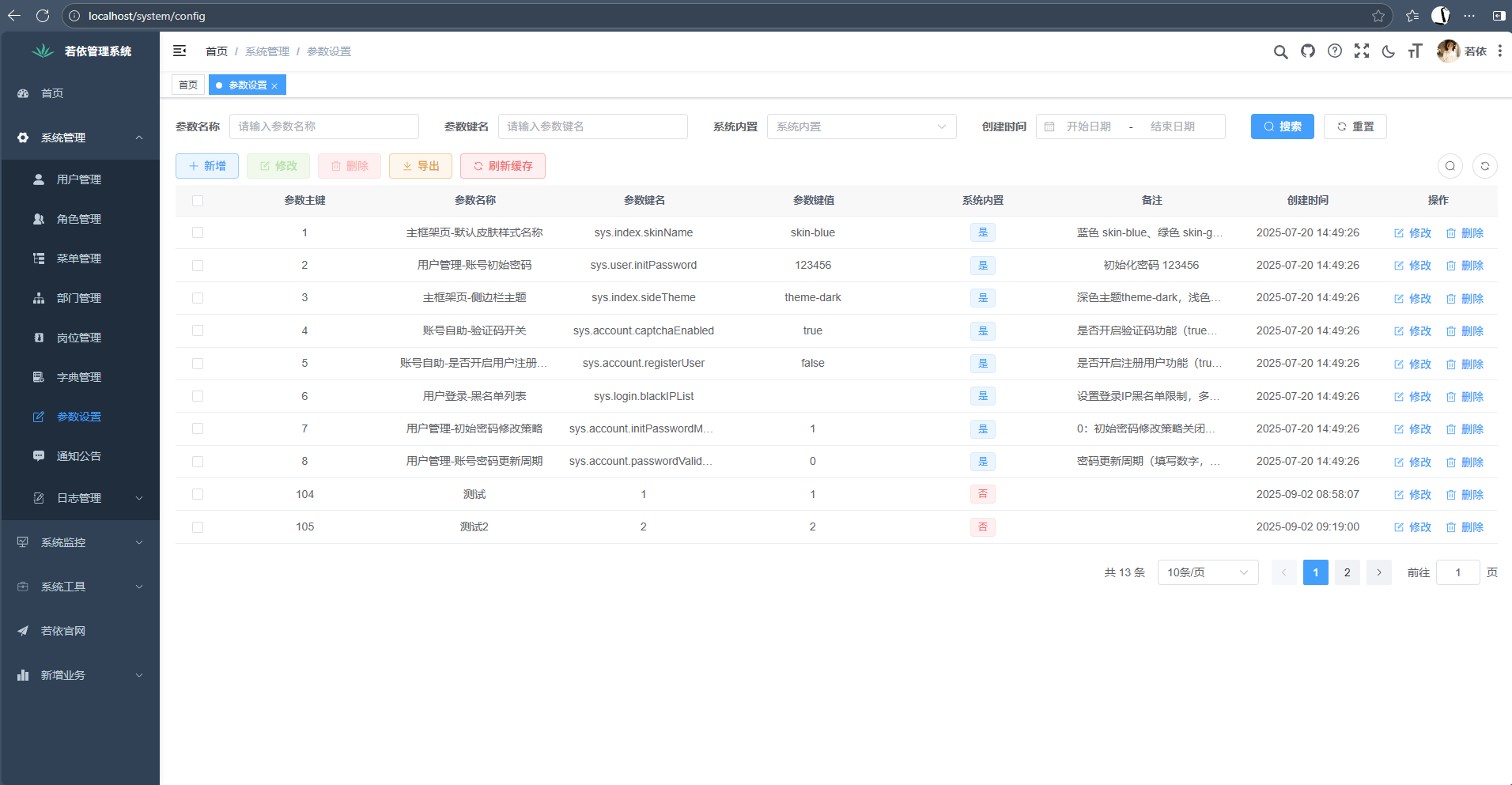
2.修改参数
2.1 点击修改按钮
2.2 修改参数键值
2.3 确定提交修改
3.刷新缓存
5.2 实现
api接口 src/api/system/config.js
- listConfig:查询参数列表
- getConfig:查询单个参数详情
- addConfig:新增参数
- updateConfig:修改参数
- delConfig:删除参数
- refreshCache:刷新参数缓存
src/views/system/config/index.vue 主要修改逻辑如下
javascript
/** 提交按钮 */
function submitForm() {
proxy.$refs["configRef"].validate(valid => {
if (valid) {
if (form.value.configId != undefined) {
updateConfig(form.value).then(response => {
proxy.$modal.msgSuccess("修改成功")
open.value = false
getList()
})
} else {
addConfig(form.value).then(response => {
proxy.$modal.msgSuccess("新增成功")
open.value = false
getList()
})
}
}
})
}当用户修改参数并提交时,会调用updateConfig API接口将更改保存到数据库。
调用refreshCache接口来清除后端缓存,确保修改的参数能够立即生效:
javascript
/** 刷新缓存按钮操作 */
function handleRefreshCache() {
refreshCache().then(() => {
proxy.$modal.msgSuccess("刷新缓存成功")
})
}
5.3 参数使用
在用户管理页面 /src/views/system/user/index.vue 中可以看到
onMounted(() => {
getDeptTree()
getList()
proxy.getConfigKey("sys.user.initPassword").then(response => {
initPassword.value = response.msg
})
})在组件挂载时执行,通过调用getConfigKey("sys.user.initPassword")获取系统配置的默认密码参数值,并将其存储在initPassword.value中。